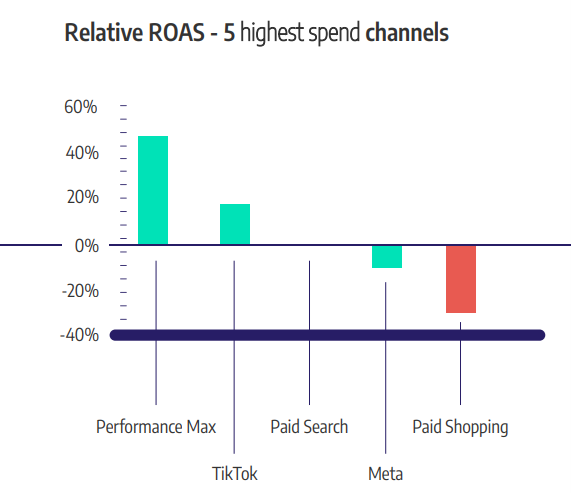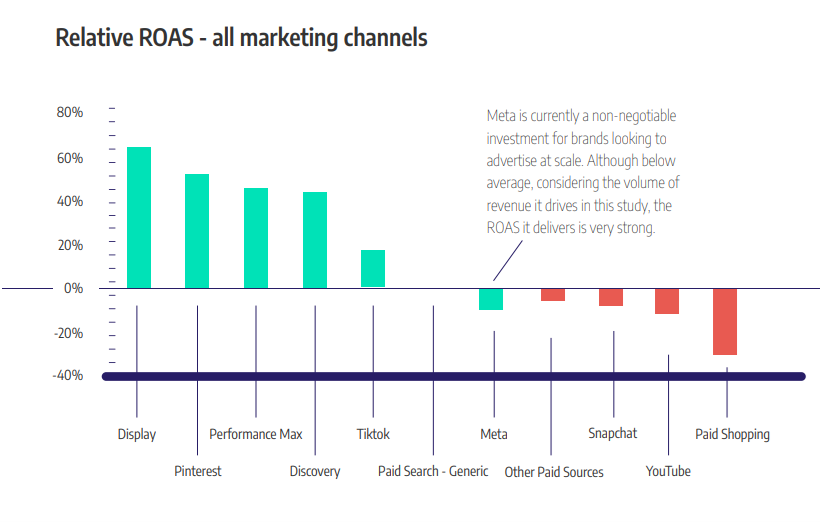30-second summary:
- The disappearance of cookies, the iOS 14 update, and the turmoil in Europe have disrupted the ecommerce industry in a major way
- Marketers need steady ground to assess the performance of their brands so that better strategies can be adopted and decisions taken for growth
- ClickZ thought leader, Jamie Bolton, discusses some of the best performing marketing channels in 2023 and what marketers can do to leverage these to the best of their ability
Before we delve into Pinterest, Performance Max and the other interesting ‘alternate’ marketing channels to boost your brand, let’s take a look at the industry as a whole.
The ecommerce industry has seen a lot of changes in the past two years. We have seen the pandemic cause an economic boom, the iOS 14 update bringing its own host of challenges, the conflict in Europe, and an impending recession all in the last couple of years. This has made it really hard for brands to figure out which marketing channels were actually working.
There are two primary reasons for this.
First, cookies are going away, so it’s getting harder to track things beyond the bottom of the funnel. This means that brands are putting too much money into certain bottom-of-the-funnel channels like direct and brand PPC and not enough into others like generic PPC and paid Social.
Second, there are a bunch of new platforms like TikTok, Pinterest, and Reddit, so the mix of channels is getting more complicated.
As marketing channels continue to evolve, it’s important for senior marketers to stay up to date on which platforms are delivering the best results. However, comparing the performance of different channels can be tricky, (Read more...) when dealing with brands of different sizes, stages, and types.
In this series of articles, I’ll be sharing the results of Fospha’s attribution model that accurately measures both click and impression-based channels to provide the broader market with insights into the best channels, platforms, and strategies for success in ecommerce in 2023 and beyond.
As you read further, we’ll take a closer look at channels that are particularly interesting for senior executive marketers: Pinterest, Performance Max, and Discovery. I’ll explore why these channels are performing well, how brands can leverage them effectively, and what strategies can be used to optimize campaigns on each platform.
Understanding Relative ROAS and its importance
Before diving into the specifics of each channel, it’s important to understand the concept of ‘Relative ROAS’ and why it’s such an important metric for evaluating channel performance.
As we mentioned earlier, ROAS can be a difficult metric to use when comparing channel performance across different types of businesses. For example, some channels are more popular with aggressive brands that have lower ROAS, while others are more popular with ecommerce brands that require a higher first-purchase ROAS.
To account for these differences, we’ve developed the concept of ‘Relative ROAS,’ which compares a channel’s performance to what “good” looks like for each brand. A relative ROAS of 0% means that a channel delivers a ROAS identical to a brand’s total blended ROAS, while a relative ROAS of 200% means that a channel is three times as effective as a brand’s blended ROAS.
Using this metric, we can gain a more accurate understanding of which channels are delivering the best results for specific types of businesses. With that in mind, let’s take a closer look at the top-performing channels.
Analyzing the top-performing channels
Using the Relative ROAS metric, we’ve listed the top-performing channels for senior executive marketers. Here are the ones that stand out:
Pinterest: A strong performer for ecommerce brands
Of all the channels analyzed in the study, Pinterest is the most interesting alternative channel for advertisers looking to expand their marketing mix. According to Fospha’s data, Pinterest is a strong performer for ecommerce brands, delivering a ROAS that is higher than the blended average for most brands. Furthermore, we have seen it scale effectively, which means that Pinterest can be a good option for brands looking to introduce a new platform to their mix.
Pinterest is a visual discovery platform that allows users to find and save ideas for everything from home decor to fashion to recipes. It has become increasingly popular with ecommerce brands, as it allows them to showcase their products in a visually compelling way and reach users who are actively searching for inspiration and ideas.
The platform is particularly effective for brands with strong product imagery and a focus on lifestyle. It also offers a range of advertising options, including standard Pins, promoted Pins, and shopping ads, making it a versatile option for brands looking to drive traffic and conversions.
While Pinterest may not be as scalable as some of the other channels analyzed in this study, its strong performance and unique user base make it a compelling option for brands looking to diversify their marketing mix.
Performance Max: A huge growth story
Performance Max is another Google channel that has performed well. According to Fospha’s data, it is now second only to Meta in terms of spend volume, delivering a ROAS that is higher than the blended average for most brands. This is an impressive feat for a channel that was only launched in 2020.
Performance Max is designed to simplify the ad creation process for advertisers by using automation to optimize ad delivery across all of Google’s properties, including Search, Display, YouTube, and Discovery. It leverages machine learning to predict where ads are likely to perform best, and automatically optimizes ad delivery to those placements. This has made it a popular choice for brands looking to maximize their reach and streamline their ad operations.
The channel’s success has been driven by a combination of factors, including its ease of use, the scale of the Google ecosystem, and its strong performance across a variety of industries. It is particularly effective for brands with high purchase intent, such as those selling products with a short sales cycle, as it can quickly drive traffic and conversions.
Despite its strong performance, it is important to note that Performance Max is not a one-size-fits-all solution. It may not be the right choice for all brands or industries, and careful testing and optimization are necessary to maximize its effectiveness.
Google Discovery: The impressive newcomer
Google Discovery is another Google channel that has performed well, delivering a ROAS that is higher than the blended average for most brands. It is a relatively new channel, having only been launched in 2019, but has quickly gained popularity among advertisers due to its ability to reach users in a more personalized and visual way.
Google Discovery ads appear in a user’s Google Discover feed, which is a personalized content feed that shows users news, articles, and other content that Google thinks will be of interest to them. These ads are displayed alongside other content in the feed and are designed to blend in seamlessly with the user’s browsing experience.
One of the main benefits of using Discovery is that it can help brands reach a wider audience that may not have been exposed to their brand before. This can be particularly beneficial for brands that are looking to expand their customer base and reach new markets. This makes it a powerful tool for building brand awareness and driving consideration among potential customers.
Overall, Google Discovery is a promising channel for brands looking to reach users in a more personalized and visually engaging way.
Paid Shopping: Underperforming and in decline
While Performance Max has been a huge success story for Google, another one of its channels, Paid Shopping, has fallen out of favor with advertisers. The channel, which includes both standard Shopping ads and Smart Shopping campaigns, has a ROAS that is significantly below the blended average for most brands.
This decline in performance can be attributed to the replacement of Smart Shopping campaigns with Performance Max. Smart Shopping campaigns were highly effective for ecommerce brands, but their performance has suffered as Google has shifted its focus to Performance Max. Standard Shopping ads, which have traditionally been a strong performer, have also seen a decline in performance. This is likely due to increased competition and rising ad costs.
This decline in performance underscores the importance of staying on top of industry trends and adapting to changing market conditions. Advertisers who fail to do so risk falling behind their competitors and missing out on potential revenue.
Meta: A dominant force in digital advertising
Let’s talk about Meta’s ROAS for a minute. Yes, it’s a bit lower than the average for the brands we analyzed. But before you hit the panic button it is essential to look at the bigger picture. Meta is by far the biggest channel in our study, accounting for a whopping 47% of total spend. And despite this massive investment, Meta still manages to deliver an impressive ROI. Also, Meta is still the only channel that can deliver the kind of scale most brands need.
Why Meta performs well
One of the reasons Meta performs well is its ability to offer precise audience targeting. The platform’s user data is incredibly detailed. This enables advertisers to target based on demographics, interests, behaviors, and more. Such level of targeting helps to ensure that ads are shown to the right people at the right time. This increases the likelihood of conversions.
Another key feature of Meta is its strong performance on mobile devices. With over 3 billion active users, the platform is the largest social media network in the world, and most of its users access it through mobile devices. This makes it an ideal channel for brands looking to reach customers on-the-go.
Meta’s success has not gone unnoticed by advertisers, and it remains one of the most popular channels for ad spend. However, with increased competition and changes to the platform’s algorithm, it is important for brands to continually optimize their campaigns in order to maximize their results. This may involve testing different ad formats, adjusting targeting options, or experimenting with bidding strategies.
We’ll dive into the details in my follow up articles. For now, let’s just appreciate the power of this platform.
Conclusion
The marketing landscape is constantly evolving, and it’s important for senior executive marketers to stay on top of the latest trends and emerging platforms. While Google and Facebook continue to dominate the digital advertising space, there are interesting alternatives that can complement these giants and offer new opportunities for brands to connect with their target audience.
Google’s Performance Max is a newcomer to the scene. However, it has already established itself as a highly effective channel for driving conversions and growth.
Pinterest is a platform that has often been overlooked by brands. But it can offer significant benefits for ecommerce businesses with visually appealing products.
It’s important for marketers to approach these alternative channels with a strategic mindset. They should take the time to understand their unique strengths and limitations and how they can be best leveraged for each brand’s specific needs. By doing so, brands can stay ahead of the competition and find new opportunities to connect with their audience and drive growth.
Jamie Bolton is a ClickZ Advisory Board Member and head of Growth at Fospha, a leading marketing measurement platform for ecommerce.
Subscribe to the ClickZ newsletter for insights on the evolving marketing landscape, performance marketing, customer experience, thought leadership, videos, podcasts, and more.


